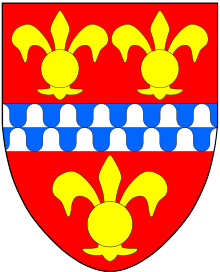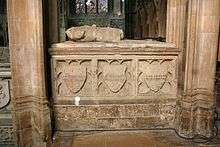Baron Cantilupe
Baron Cantilupe (properly Cauntelo[6]) was a title created in the peerage of England by writ on 29 December 1299 addressed to Willelmo de Canti Lupo or Cauntelo,[7] (William de Cantilupe (1262-1308) of Greasley Castle in Nottinghamshire and of Ravensthorpe Castle in the parish of Boltby, North Yorkshire).



_LincolnCathedral.jpg)

.jpg)
History
The name has numerous variations in spelling (Canteloupe, Cauntiloue, Cauntelou, Cantiloue, Cauntilieu, Cantelo, Canteloo, Cantelowe, Cantlow, etc.) with a Latinized form de Cantilupo.[8] The standard spelling used by modern historians is "Cantilupe".
The de Cantilupe family which came to England at some time after the Norman Conquest of 1066 originated at one of several similarly named manors in Normandy, from which they took their name: Canteloup in Calvados, east of Caen[9] or Chanteloup in Bréhal,[10] Manche, or Canteloup in Manche east of Cherbourg on the tip of the Cherbourg Peninsula.
The de Cantilupe family of Greasley was a junior branch of a prominent Anglo-Norman family, descended from Sir Nicholas de Cantilupe (d.1266) who married Eustachia FitzHugh, heiress of Greasley.[11] Sir Nicholas was the 5th and youngest son of William II de Cantilupe (d.1251), 2nd feudal baron of Eaton Bray[12] in Bedfordshire, steward of the household to King Henry III (whose own father William I de Cantilupe (died 1239) had been steward of the household to King John, father of Henry III). Sir Nicholas's uncle was Walter de Cantilupe (1195-1266), Bishop of Worcester and his elder brother was Thomas de Cantilupe (1220-1282), Chancellor of England, Bishop of Hereford, who was canonised as a saint in 1320. The senior line died out in the male line in 1273 on the death of the 22 year-old George de Cantilupe (1251-1273), 4th feudal baron of Eaton Bray, Lord of Abergavenny, who had inherited vast Welsh estates from his mother Eva de Briouze. In 1349, long after the extinction of the senior line of the family, it was Nicholas de Cantilupe, 3rd Baron Cantilupe (c.1301-1355) of Greasley, who hosted the important ceremony in Hereford Cathedral of translating the relics of his great-uncle Saint Thomas de Cantilupe into the new shrine prepared for them.[13]
The 1st Baron signed and sealed the Barons' Letter of 1301 to the pope (as Dominus de Ravensthorpe, "lord (of the manor) of Ravensthorpe") and was present at the Siege of Caerlaverock Castle in Scotland in 1300, when his armorials, a version of the arms of the senior line differenced by a fess vair (as seen on his surviving 1301 seal), were blazoned in verse in the Caerlaverock Roll. He married Eve de Boltby, heiress of Boltby and of Ravensthorpe Castle within that manor,[14] and is believed to be represented by the heavily restored recumbent effigy of a knight in Felixkirk Church, adjacent to Ravensthorpe Castle in Yorkshire (alternatively John de Walkyngham (d.1284)[15]).
He was succeeded by his eldest son by Eve de Boltby, namely William de Cantilupe, 2nd Baron Cantilupe (1293-c.1321), who was involved in the murder of Piers Gaveston, favourite of King Edward II, and in 1313 begged on his knees for the forgiveness of that king, after which he relinquished his estates to his younger brother. He died aged 28, unmarried. He was succeeded by his younger brother Nicholas de Cantilupe, 3rd Baron Cantilupe (c.1301-1355), who in 1343 founded Beauvale Priory[16] within his deer park at Greasley, with the consent of his distant cousin William La Zouche, Archbishop of York (the Zouche family was one of the two co-heirs of the senior line on the death of George de Cantilupe (1251-1273), 4th feudal baron of Eaton Bray, Lord of Abergavenny, descended from one of his two sisters. Amongst the many Cantilupe manors they inherited was Harringworth which they made their seat. (See Baron Zouche "of Haryngworth")). He served as Governor of Berwick from 1335. He was buried in Lincoln Cathedral where survives his severely mutilated recumbent effigy on a chest tomb, displaying the sculpted arms of Cantilupe of Greasley. He disinherited his son[17] (by his first wife "Tiphane") William de Cantilupe, 4th Baron Cantilupe (1325-c.1375), last in the male line who was predeceased by his two sons, Nicholas de Cantilupe (1342-1371) of Greasley, eldest son and heir of his grandfather, slain at Avignon[18] trying to petition the pope into reversing the annulment of his marriage which had been obtained by his wife Katherine Paynel, supposedly on the grounds of impotence.[19] He died without issue when his heir became his younger brother William de Cantilupe (1344-1375), murdered by his cook and squire, possibly at the behest of his wife Maud Neville, which murder became a celebrated criminal lawsuit,[20] see Murder of William de Cantilupe.[21]
Barons Cantilupe (1299)
- William de Cantilupe, 1st Baron Cantilupe (1262-1308)
- William de Cantilupe, 2nd Baron Cantilupe (1293-c.1321) (son)
- Nicholas de Cantilupe, 3rd Baron Cantilupe (c.1301-1355) (brother)
- William de Cantilupe, 4th Baron Cantilupe (1325-c.1375) (son)
Sources
- GEC Complete Peerage, vol.3, pp.111-116
- Sanders, I.J. English Baronies: A Study of their Origin and Descent 1086–1327, Oxford, 1960, pp.39-40
Further reading
- M Julian-Jones, Thesis on de Cantilupe and Corbet families, 2015, Online Research @Cardiff (ORCA), Cardiff University
- Frederik Pedersen (Senior Lecturer at the University of Aberdeen), 2012 youtube video discussing the termination of the Cantilupe family and the family in general
References
- GEC Complete Peerage, vol.3, p.111, note c), of the leopard's faces little physical evidence exists apart from the verse blazon in the Caerlaverock Roll (1300). The seal of the 1st Baron (d.1308) appended to the Barons' Letter, 1301, shows no leopard's faces nor does the sculpted shield of the 3rd Baron (d.1355) on the Cantilupe Chantry by Lincoln Cathedral, which does show an over-sized boss on the fleurs-de-lys, on which possibly any relief detail has worn away
- GEC Complete Peerage, vol.3, pp.111-2
- National Archives 1301.
- according to a 1947 inscribed window in St Mary's Church, Greasley
- The Archbishop was the son of Nicholas's second cousin
- GEC, p.111
- GEC, p.112
- The oft-quoted translation of the Latinized form as "from the song of the wolf" would be de cantu lupi and "from the singing wolf" would be de cantanti lupo, of which de canti lupo might be an abbreviation. However it appears from the early pre-heraldic seals of the family that some play was made on the Latin noun Lupus, "wolf" (see M Julian-Jones, Thesis on de Cantilupe and Corbet families, 2015, Online Research @Cardiff (ORCA), Cardiff University)
- Nicholas Vincent, biography of Sir George de Cantilupe (d.1273), Oxford Dictionary of National Biography, p.953
- GEC, vol.3, p.111, note c
- GEC Complete Peerage, p.111
- Sanders, I.J. English Baronies: A Study of their Origin and Descent 1086-1327, Oxford, 1960, pp.39-40
- Oxford Dictionary of National Biography, Bishop Thomas Cantilupe
- GEC, p.112
- http://www.medievalcombatsociety.org.uk/index.php/research/armour-in-effigy/armour-effigies
- GEC, p.113
- GEC, p.113/114
- GEC, p.115
- Frederik Pedersen, Murder, Mayhem and a Very Small Penis: motives for revenge in the 1375 murder of William Cantilupe, great-great nephew of St. Thomas of Hereford, paper given at the Institute of Historical Research, 9 November 2012
- Frederik Pedersen, Marriage Disputes in Medieval England, London, 2000
- see also 2012 youtube video of Frederik Pedersen (Senior Lecturer at the University of Aberdeen) discussing the case